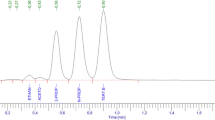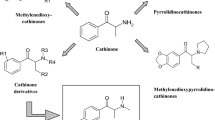Abstract
After ingestion of 6–10 g camphor, 2 men were admitted to the clinic in a state of acute intoxication. The clinical symptomatology was characterized by psychomotoric agitation and hallucinations. Both patients, who used to take hashish and ephedrine, had taken camphor as a stimulant.
The blood and urine concentrations of camphor were determined by gaschromatography/mass spectrometry. Six metabolites of camphor could be detected in urine. The main metabolic pathways are hydroxylation in the 3-,5-, 8-, and 9-position, and a subsequent oxidation to the corresponding ketone and carbonic acid, the latter of which is excreted as a glucuronide. The plasma protein binding was determined by ultrafiltration (61%). In vitro hemoperfusion experiments were carried out with amberlite and activated charcoal. Amberlite proved to be more effective than activated charcoal. Repeated analysis of urine samples gave evidence for microbiological reduction of camphor to isoborneole.
Similar content being viewed by others
References
Aronow R, Spigiel RW (1976) Implications of camphor poisoning. Drug Intel Clin Pharmacol 10: 631
Boukma DW (1976) Camphor poisonings. Hosp Pharmacol 11: 207
Clarke EGC (1969) Isolation and identification of drugs. The Pharmaceutical Press London
Ginn HE, Anderson KE, Mercier RK (1968) Camphor intoxication treated by lipid hemodialysis. JAMA 203: 230
Kopelman R, Miller S, Kelley R, Sunshine I (1979) Camphor intoxication treated by resin hemoperfusion. JAMA 241: 727
Martindale R (1977) The extra pharmacopoeia. The Pharmaceutical Press, London
Phelan JP (1976) Camphor poisoning. Pediatrics 57: 428
Ryan MT, Hanna NS (1971) Investigation of equilibrium ultrafiltration as a means of measuring steroid protein binding parameters. Anal Biochem 40: 364
Segal S (1978) Camphor: Who needs it? Pediatrics 62: 404
Seyffart G (1979) Giftindex, Fresenius Stiftung, Bad Homburg
Skoglund RR, Ware LL, Schauberger IE (1977) Prolonged seizures due to contact and inhalation exposure to camphor. Clin Pediatr 16: 901
Smith AG, Margolis G (1954) Anatomical and pharmacologic study: Report of a fatal case. Experimental investigation of protective action of barbiturates. Am J Pathol 30: 857
Trestrail IH, Spartz ME (1977) Camphorated and castor oil confusion and its toxic results. Clin Toxicol 11: 151
Vohland HW, Streichert B (1978) Proteinbindung von Carbromal. Arch Toxicol 41: 69
Author information
Authors and Affiliations
Rights and permissions
About this article
Cite this article
Köppel, C., Tenczer, J., Schirop, T. et al. Camphor poisoning. Arch Toxicol 51, 101–106 (1982). https://doi.org/10.1007/BF00279325
Received:
Issue Date:
DOI: https://doi.org/10.1007/BF00279325




